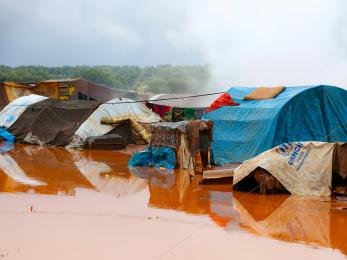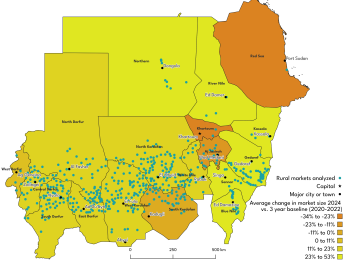Remote Sensing to Monitor and Anticipate Impact of Conflict on Agriculture in Sudan
Download the September 2023 report ▸
Download the August 2023 report ▸
Since April 2023, increased conflict in Sudan has had a profound impact on food security across the country. Currently, an estimated 42% of people are unable to consume adequate food, putting their lives or livelihoods in danger. Domestic agricultural production is critically important as it supports availability of food – particularly sorghum and millet, staple parts of the diet – and is the main source of livelihood for much of the population.
Mercy Corps in Sudan aims to reduce vulnerability and increase income and food security for farmers. For example, between July 2019 and April 2023, Mercy Corps partnered with ADRA to support 31,000 male and female smallholder farmers, through enhanced gender-equitable market access and agricultural production in Blue Nile and South Kordofan states (via the Strengthening Agricultural Markets and Food Security [SAFE] programme funded by SIDA). Assistance has continued throughout 2023: between the June-September planting season, Mercy Corps provided agricultural support to over 5,800 smallholder farmers, including initiatives like e-voucher seed fairs and providing climate-resilient and affordable planting seeds.
The conflict that broke out earlier this year has created significant additional challenges for farmers across Sudan. During the planting season, in some locations farmers faced direct security threats, and in all states, it was extremely difficult to obtain critical inputs. Whilst a Mercy Corps survey in Blue Nile and South Kordofan found that 90% of farmers had started preparing their field or intended to plant in July 2023, potential impact of reduced inputs was difficult to assess. Further, conflict has significantly increased access challenges across the country, meaning large-scale and regular primary data collection is extremely challenging.
Remote Sensing: Country-Wide Anticipatory Analysis
To better understand and anticipate potential impact of conflict on agriculture across the entire country, Mercy Corps Technology for Development (T4D), Crisis Analysis, and Sudan teams collaborated to conduct remote sensing analysis. This used satellite imagery to monitor the Normalized Difference Vegetation Index (NDVI) in agricultural areas across Sudan, and compare the average vegetation to previous years, serving as a rough proxy for potential agricultural production. Key findings include:
- Early analysis in July 2023 indicated that vegetation levels in agricultural areas in Sudan were generally high compared to long-term averages, likely due to good early season rainfall and following a positive harvest for many staple crops in 2022.
- However, from August, vegetation levels started to fall below previous years. By mid-September, when vegetation usually peaks, 2023 vegetation levels were lower than most previous years (with the exception of 2015 and 2017, which saw particularly poor harvests). This is despite above-average rainfall across the country.
- The downward trend in vegetation indicates that the harvest is unlikely to be as positive as last year: comparing vegetation peaks in previous years to the annual national cereal production indicates that there may be some correlation between higher vegetation levels and better harvests, though this has not been statistically tested and is indicative only.
- Certain areas stand out as particularly affected. Khartoum exhibited a decrease in average vegetation levels from July 2023, which progressively worsened as the season continued. Agricultural activity, both smallholding and commercial, was reported to be disrupted by presence or occupation by armed groups and proximate violent conflict, as well as lack of agricultural inputs and a fall in demand.
- Across the east of Sudan, by September the vegetation index anomaly (difference with 10-year average) declined compared to July, despite reasonable rains. Irrigated areas and large-scale industrial farms that rely on fuel-powered machinery or intensive early funding appear to be particularly affected.
- Gedaref state, a key producer of sorghum, has been relatively unaffected by direct conflict and is relatively accessible for humanitarian actors. Whilst at the end of July, vegetation levels were higher than 10-year averages, by mid-September, some areas in the north and west had started to decline despite reasonable rains.
- With the upcoming harvest season, a critical issue will be ensuring that farmers are supported to harvest and sell their produce, given that key sorghum markets such as Khartoum and El Obeid may continue to be disrupted by conflict.

